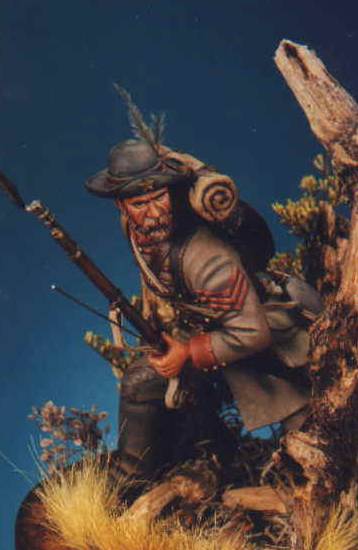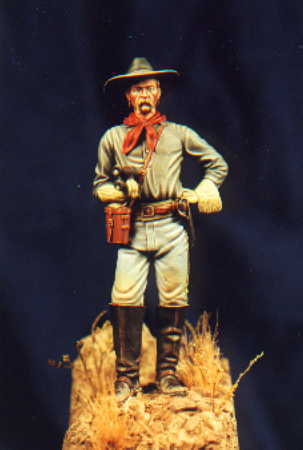
11th Mississippi - 1861 by Greg Heilers
This conversion project started life as various pieces from my "morgue". The pieces, kindly donated by Mr. Mike Stelzel, are from his extensive Michael Roberts Ltd. line. After cutting apart all the segments at the joints, the figure was re-animated to the resulting configuration: a lone skirmisher in the act of achieving his goal.
I have always had a strong interest in uniforms and battles of the early part of the American Civil War, due to their colors, varieties, and seemingly unorganized characteristics. Coming upon several illustrations dealing with State troops, I was immediately drawn to Mississippi. The gray frock coat, adorned with red trim (including musician-style taping across the torso) caught my eye. The addition of the black slouch hat, and feathers, all part of Mississippi regulations, resulted in a very attractive combination.
To further alleviate the stock-figure look, I did minor resculpting on the face: the eyes and brow were lowered to give a more intense look, the nose was widened slightly, the facial muscles accentuated, and the facial hair altered. The coat tails were formed from rolled-out epoxy putty (Super Glue brand radiator seal). Other sculpting work was carried out using either the radiator putty, or A&B, or even a mixture of the two. As a final touch, I liberated three tiny feathers, from a duster at work, and gave them a new life as a 19th century hat adornment.
After priming the finished sculpture with a gray enamel spray, painting began. All undercoating was done with acrylics: either Jo-Sonja, or Ceramacoat brands. The colors were then filled in using Winsor Newton artist's oils. Earthy grays and browns, in small amounts, were mixed in to all the uniform colors, in order to tone them down, blend them together, and represent the vegetable dyes used during that era.
The groundwork began with a Celluclay base, with various pieces of natural ground cover on top, which can be found at any good hobby shop, or arts and crafts store. The tree was rescued from my parents' kindling pile, it being genuine Texas live oak. Since this wood was extremely old and dry, and easily fell apart at the slightest touch, it was coated with cyanoacrylate glue, to preserve and strengthen it; in effect, petrifying it.
The finish piece has proven to be quite dramatic, drawing favorable comments when exhibited, due to the implied drama of the soldier peeking around the tree, waiting for the right moment to take his shot. Ensuring one always considers the "wow factor" is the one piece of advice I hope everyone takes away from this. It is an often overlooked aspect of our hobby, and should be stressed more often.
